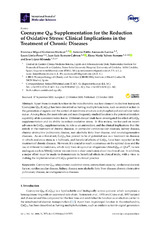Coenzyme Q10 Supplementation for the Reduction of Oxidative Stress: Clinical Implications in the Treatment of Chronic Diseases
Autor
Gutiérrez Mariscal, Francisco Miguel
Arenas de Larriva, Antonio P.
Limia-Pérez, Laura
Romero-Cabrera, Juan Luis
Yubero-Serrano, Elena M.
López-Miranda, José
Editor
MDPIFecha
2020Materia
Coenzyme Q10Ubiquinone
Oxidative stress
Antioxidant capacity
Cardiovascular risk factors
Cardiovascular disease
Kidney disease
Non-alcoholic fatty liver disease
Chronic obstructive pulmonary disease
Neurodegenerative diseases
METS:
Mostrar el registro METSPREMIS:
Mostrar el registro PREMISMetadatos
Mostrar el registro completo del ítemResumen
Apart from its main function in the mitochondria as a key element in electron transport, Coenzyme Q10 (CoQ10) has been described as having multiple functions, such as oxidant action in the generation of signals and the control of membrane structure and phospholipid and cellular redox status. Among these, the most relevant and most frequently studied function is the potent antioxidant capability of its coexistent redox forms. Different clinical trials have investigated the effect of CoQ10 supplementation and its ability to reduce oxidative stress. In this review, we focused on recent advances in CoQ10 supplementation, its role as an antioxidant, and the clinical implications that this entails in the treatment of chronic diseases, in particular cardiovascular diseases, kidney disease, chronic obstructive pulmonary disease, non-alcoholic fatty liver disease, and neurodegenerative diseases. As an antioxidant, CoQ10 has proved to be of potential use as a treatment in diseases in which oxidative stress is a hallmark, and beneficial effects of CoQ10 have been reported in the treatment of chronic diseases. However, it is crucial to reach a consensus on the optimal dose and the use of different formulations, which vary from ubiquinol or ubiquinone Ubisol-Q10 or Qter®, to new analogues such as MitoQ, before we can draw a clear conclusion about its clinical use. In addition, a major effort must be made to demonstrate its beneficial effects in clinical trials, with a view to making the implementation of CoQ10 possible in clinical practice.
Fuente
International Journal of Molecular Sciences 21(21), 7870 (2020)Versión del Editor
http://dx.doi.org/10.3390/ijms21217870Ítems relacionados
Mostrando ítems relacionados por Título, autor o materia.
-
Ceruloplasmin and its involvement in cardiovascular disease
Arenas de Larriva, Antonio P. (Universidad de Córdoba, UCOPress, 2022)INTRODUCTION: Inflammation and oxidative stress play a key role in the initiation and maintenance of atherosclerosis and are related to the occurrence of events leading to vessel occlusion, both in the venous system ... -
Understanding Spatio-Temporal Variability in the Reproduction Ratio of the Bluetongue (BTV-1) Epidemic in Southern Spain (Andalusia) in 2007 Using Epidemic Trees
Napp, Sebastián; Allepuz, Alberto; Purse, B.V.; Casal, Jordi; García-Bocanegra, Ignacio; Burgin, L.E.; Searle, K.R. (Public Library of Science, 2016)Andalusia (Southern Spain) is considered one of the main routes of introduction of bluetongue virus (BTV) into Europe, evidenced by a devastating epidemic caused by BTV-1 in 2007. Understanding the pattern and the drivers ... -
Study on the mortality in Ecuador related to dietary factors
Neira Mosquera, Juan Alejandro; Sánchez-Llaguno, Sungey; Moreno Rojas, Rafael; Pérez Rodríguez, Fernando (Grupo Aula Médica (Madrid), 2013)Diet is an important factor related to the development of numerous diseases. In developing countries like Ecuador, this aspect is not considered as priority however, the study of the incidence of certain diet-related ...

